Let’s face it, when it comes to weddings and rituals, we come from a generation where most of us do what our families tell us to do, and don’t really know why we are doing them, or what the meaning behind each element really is.
As we continue to grow in the age of social media, some of these elements continue to change and adapt to modern settings, but there is a meaning behind everything we do and in each step we take during a Hindu ceremony that isn’t so crazy after all! Some of these apply to a majority of South Asian weddings as well, but here is a quick insight into what the main elements mean:
1. What’s the Real Reason to Apply Mehndi?
There are many tales as to why brides wear mehndi. Besides the fact that it’s a gorgeous form of art, the most popular myth is that the darker your mehndi gets, the more your partner or mother-in-law loves you. But did you know the real reason is to reduce stress? Natural henna has medicinal herbal remedies in it. Once applied, it’s supposed to cool your body and reduce your levels of stress. Hence placing it on your hands and feet to cool the nerve-endings of your body!

2. Why Do we Apply Haldi (Tumeric) on Us Before the Wedding?
You’re probably asking yourself, why do I have to rub yellow stuff on me that’s going to stain every inch of my body (including my freshly done nails)? Just like applying mehndi, there are a few traditional reasons, and then scientific reasons behind it.
Most of you have been told that once your haldi is applied, you can’t leave your home. This is because it’s said that haldi wards off any nazar (form of evil or bad omen) that might harm you before your wedding day. Haldi is also known as purifying or cleansing your body and marks the beginning of your new life together.
But really, turmeric has an active compound in it called “curcumin”. It’s acts as a natural remedy for anxiety and headaches – perfect for anyone getting married! Turmeric is also great for brightening your skin and removing any dead cells to rejuvenate your skin before you walk down the aisle.
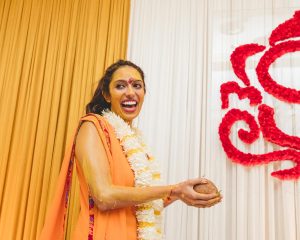
3. Why do Brides Wear Gold Tassels from Their Bracelets (Kaleera)?
The myth behind a bride wearing Kaleeras is that it is a form of blessing, and once the ceremony is done, she is supposed to shake her wrists over the heads of her bridesmaids, and whoever the first one falls on would be next to get married. But, did you know that the history behind a bride wearing her kaleeras has nothing to do with this? Traditionally, kaleeras were made from dried coconuts and had strands of nuts, dried fruits, and other snacks. This was meant to be a snack for the bride as she traveled to her groom’s home, and also represented a blessing for her to never run out of food in her new home.
If you look at the modern day kaleera now, you can see that it still looks like a coconut with small beads that represent nuts. I don’t know about you, but having snacks to munch on my wedding day sounds like a great idea!

4. Why Jai Mala’s?
Floral garlands are a form of welcoming each other. You’ll notice that before the ceremony, some families partake in a “milni”, which is essentially the families meeting and welcoming each other. Once the ceremony begins, the bride and groom exchange garlands as a form of uniting the two families, and the start of their new beginning. In some cultures, the bride and groom exchange their garland at the end of the ceremony to mark their beginning at that point once all the rituals have been completed.

5. Walking Around the Fire 4 Or 7 Times (Mangal Phere)?
Again, each culture has a different belief. For example, Sindhis and Gujaratis take 4 pheras (walking around the fire), while most others take 7. The first 4 pheres represent the for main aims in life: Dharma (duty to God), Artha (duty to help others and prosper together), Kama (to support each other ‘for better or for worse’), and Moksha (liberation from suffering once they are married). Typically, the Groom will lead first with the bride leading the last few rounds signifying her love and devotion.
These steps are not to be confused with the Sapta Padi, which are the 7 steps, or vows that are taken after. Through years of interpretations and translations, there are discrepancies between the two, but regardless, at least 4 rounds are made around the fire to solidify your marriage, and then your 7 steps are taken as your promise to each other.
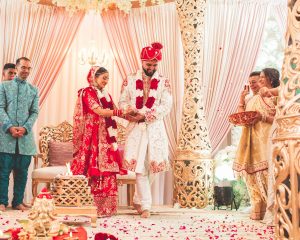
6. Why Do We Throw Puffed Rice into A Fire?
Puffed rice is a symbol of prosperity from its ability to grow. Traditionally, the bride’s brother will give her a handful of the rice as they make each round around the fire. The brother places the rice in the hands of the bride as a symbol of growth – just as rice is transplanted for prosperity, he is now giving his approval and blessings for her to move on to the next step in her life, supporting her growth in her new home. As the bride passes the rice on to her groom and he throws it into the fire, it’s his way of acknowledging the love and care that’s being entrusted in him and is now praying that she achieves the growth and stability as they start their new life.
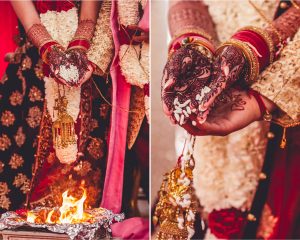
7. Why Do We Apply Sindoor?
Sindoor is a red powder composed of cinnabar, turmeric and lime. Sindoor is the first element that is applied to a bride on her wedding day to signify that she is a married woman. Depending on the type of culture, some choose to apply the sindoor under a sheet (in the West Indian culture it is believed this is your first sacred moment that should just be shared between the two of you); while in other cultures, it is believed that everyone should see that you are now married. The colour itself is meant to represent strength, fire and blood. Did you also know that once sindoor is wiped off once her husband passes away, it signifies the woman as now being a widow? Just like the other elements we’ve mentioned, sindoor also has a few health benefits. The mercury is supposed to cool the body down and give a feeling of relaxation – be careful not to use too much as there are concerns with the overuse of mercury.
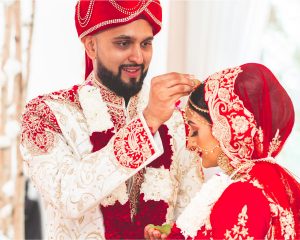
8. Why do Wear a Mangal Sutra?
The traditional Mangal Sutra is made from black beads and a pendent, and usually made out of gold. Just like wearing a wedding ring and sindoor, wearing a Mangal Sutra marks a woman as married. Knotting the threads are meant to symbolize “until death do us part”. The black beads are also known for protecting both the bride and groom from any evil. Aside from the religious reasons for wearing the necklace, there are medicinal reasons as well – pure gold is supposed to have healing properties.
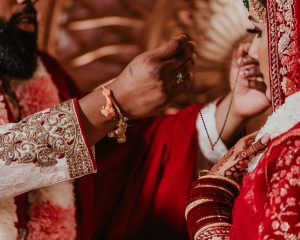
9. Why do Brides Throw Rice Behind Them When They Leave During Their Vidaai?
Throwing rice behind you is not just for that picture-perfect moment! The reason why brides throw rice as they are leaving is to signify gratitude for their parents. It’s a sign of respect and thanking your parents for essentially feeding you and taking care of you throughout your life. Throwing the rice is like showering the unconditional love back to them – and that’s why you will see the mother of the bride standing behind catching the grains in her dupatta.
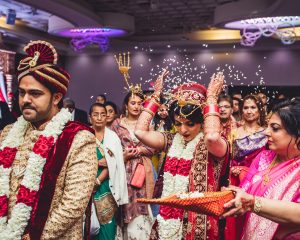
10. Why Are Brides Supposed to Kick a Cup of Rice When They Enter the Groom’s Home After the Ceremony?
The bride entering her “new home” is called the Griha Pravesha. Before they enter, the groom’s mom blesses the newlyweds by doing aarti (circling fire on a tray around them), similar to what the bride’s mom did to the groom when she welcomed him to the ceremony. As the bride takes her first step into the house, she is supposed to kick a kalash (pot) filled with rice using her right foot. In some cultures, the bride will then step into a dish with red liquid and leave her red footprints on the ground (nowadays we use a white sheet or bristol board). This is meant to represent the arrival of the Goddess Lakshmi. As we’ve mentioned above, rice is a sign of prosperity, so the bride knocking over a cup of rice is like bringing in that prosperity into her new home.

The next time you go to a Hindu wedding, look out for these elements, and now you can enlighten everyone on the meaning behind the wedding fun!
Written By:
Susan Ramroop, Beyoutiful Beginnings
Rominder Saini, Flashing Lights Photography





